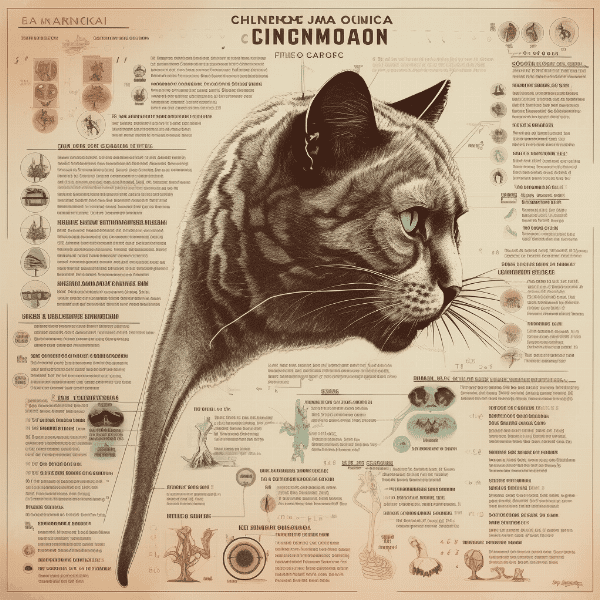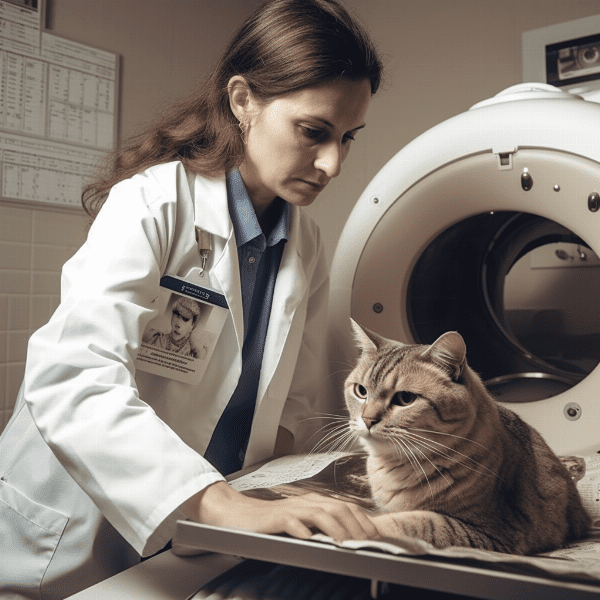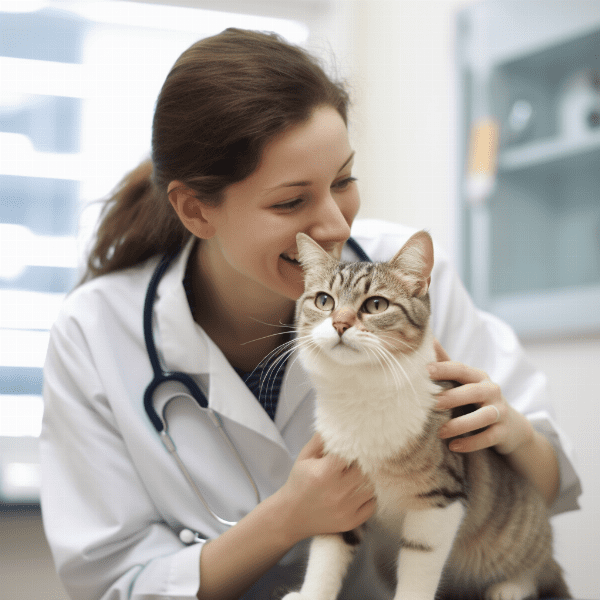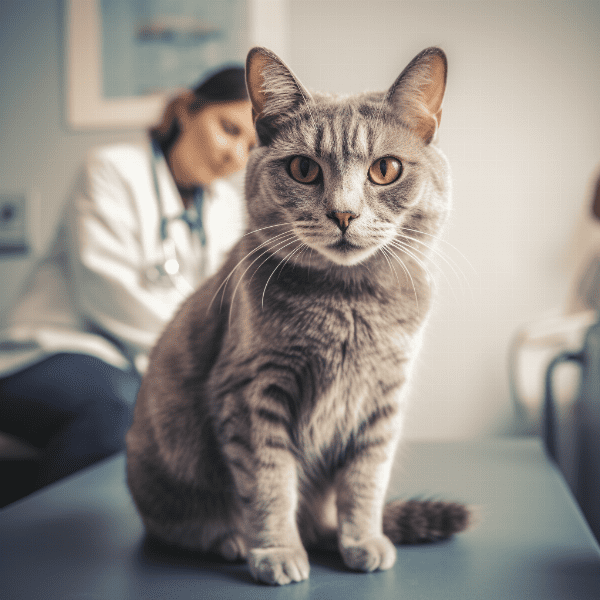Table of Contents
- Understanding Feline Cancer
- Types of Cancer in Cats
- Causes of Feline Cancer
- Early Warning Signs of Cat Cancer
- Diagnosing Cancer in Cats
- Treatment Options for Feline Cancer
- Coping with a Cancer Diagnosis in Your Cat
- Preventing Feline Cancer
- Importance of Regular Vet Check-ups for Cats
- Living with a Cat with Cancer: What to Expect
Understanding Feline Cancer
Feline cancer is a condition that occurs when abnormal cells grow uncontrollably in a cat’s body. These cells can form tumors, which can be benign or malignant. Malignant tumors can be life-threatening if not treated promptly.
The Role of DNA in Feline Cancer
DNA mutations are the primary cause of cancer in cats. Mutations occur when DNA is damaged, and the body’s natural repair mechanisms fail to fix it. These damaged cells then replicate, leading to the formation of a tumor.
Age and Breed Predisposition
Cancer in cats can occur at any age, but older cats are more likely to develop the disease. Additionally, certain breeds, such as Siamese, Persian, and Himalayan cats, are more prone to certain types of cancer.
Common Types of Feline Cancer
There are many types of feline cancer, each with its own unique symptoms and treatment options. Some of the most common types of feline cancer include lymphoma, squamous cell carcinoma, and mammary gland tumors.
Conclusion
Understanding the underlying causes and risk factors for feline cancer is critical for early detection and treatment. By being aware of the signs and symptoms of cancer in cats, you can help ensure that your feline companion receives prompt medical attention if necessary.

Types of Cancer in Cats
Cancer can occur in any part of a cat’s body, and the symptoms can vary depending on the type of cancer. Here are some of the most common types of cancer in cats:
Lymphoma
Lymphoma is a cancer that affects a cat’s lymphatic system, which is responsible for fighting infection and disease. This type of cancer is typically found in a cat’s lymph nodes, but it can also affect other organs such as the liver, spleen, and gastrointestinal tract. Symptoms of lymphoma in cats include lethargy, weight loss, vomiting, and diarrhea.
Squamous Cell Carcinoma
Squamous cell carcinoma is a type of skin cancer that typically affects a cat’s ears, nose, and mouth. This type of cancer is more common in cats with light-colored skin and is often caused by excessive sun exposure. Symptoms of squamous cell carcinoma in cats include sores, ulcers, and scabs that do not heal.
Mammary Gland Tumors
Mammary gland tumors are one of the most common types of cancer in female cats, and they can be benign or malignant. These tumors are usually found in a cat’s mammary glands and can cause swelling, discharge, and ulceration.
Bone Cancer
Bone cancer, also known as osteosarcoma, is a rare type of cancer that can occur in a cat’s bones. This type of cancer is more common in larger breeds of cats, and the symptoms include lameness, pain, and swelling.
Conclusion
It’s essential to be aware of the different types of cancer that can affect your cat, as early detection and treatment can greatly improve your cat’s chances of recovery. If you notice any unusual symptoms or changes in your cat’s behavior, it’s important to seek veterinary care right away.

Causes of Feline Cancer
The exact cause of cancer in cats is not always clear, but there are several factors that can increase a cat’s risk of developing the disease. Here are some of the most common causes of feline cancer:
Genetic Predisposition
Certain breeds of cats are more prone to certain types of cancer. For example, Siamese cats are more likely to develop lymphoma, while Persians are more prone to squamous cell carcinoma. If you have a purebred cat, it’s important to be aware of any breed-specific cancer risks and take preventive measures accordingly.
Environmental Factors
Exposure to environmental toxins can increase a cat’s risk of developing cancer. Secondhand smoke, household cleaners, and lawn chemicals are just a few examples of environmental toxins that can be harmful to your cat. If possible, try to limit your cat’s exposure to these types of toxins.
Age
As cats age, their risk of developing cancer increases. This is partly because older cats have had more time to accumulate DNA mutations, which can lead to cancer. Additionally, older cats may have a weaker immune system, making them more susceptible to cancer.
Viruses
Some viruses can increase a cat’s risk of developing cancer. For example, the feline leukemia virus (FeLV) and the feline immunodeficiency virus (FIV) are both linked to a higher risk of certain types of cancer.
Conclusion
While the exact cause of cancer in cats is not always clear, there are several factors that can increase a cat’s risk of developing the disease. By being aware of these factors, you can take steps to minimize your cat’s risk and keep them healthy and happy for years to come.

Early Warning Signs of Cat Cancer
Cancer in cats can be challenging to diagnose, as many of the symptoms can be vague and nonspecific. However, there are some early warning signs that can indicate a potential problem. Here are some of the most common early warning signs of cat cancer:
Changes in Appetite
A sudden loss of appetite or a significant increase in appetite can be a sign of cancer in cats. If your cat’s eating habits change, it’s essential to seek veterinary care.
Lumps and Bumps
Unusual lumps or bumps on your cat’s body can be a sign of cancer. It’s important to note that not all lumps are cancerous, but any new or growing lump should be examined by a veterinarian.
Weight Loss
Unexplained weight loss is a common symptom of cancer in cats. If your cat is losing weight without a change in diet or exercise, it’s essential to seek veterinary care.
Vomiting or Diarrhea
Chronic vomiting or diarrhea can be a sign of cancer in cats. If your cat is experiencing these symptoms, it’s essential to seek veterinary care.
Conclusion
Early detection is key to successfully treating cancer in cats. By being aware of the early warning signs of cat cancer, you can ensure that your feline companion receives prompt medical attention if necessary. If you notice any unusual symptoms or changes in your cat’s behavior, it’s important to seek veterinary care right away.

Diagnosing Cancer in Cats
Diagnosing cancer in cats can be challenging, as many of the symptoms can be vague and nonspecific. Here are some of the most common methods used to diagnose cancer in cats:
Physical Examination
A physical examination is usually the first step in diagnosing cancer in cats. During this examination, a veterinarian will look for any lumps, bumps, or other abnormalities that could indicate cancer. They may also take a blood sample to check for any abnormal cells.
Imaging Tests
Imaging tests, such as X-rays, ultrasounds, and CT scans, can be used to identify tumors or other abnormalities in a cat’s body. These tests can also help determine the size and location of a tumor.
Biopsy
A biopsy involves removing a small piece of tissue from a suspicious area and examining it under a microscope. This test can help determine if a tumor is cancerous and what type of cancer it is.
Blood Tests
Blood tests can be used to check for abnormalities in a cat’s blood cells, such as anemia or high white blood cell counts. These abnormalities can be a sign of cancer or other health problems.
Conclusion
Diagnosing cancer in cats can be challenging, but with the help of a veterinarian, it is possible to identify and treat the disease. If you suspect that your cat may have cancer, it’s essential to seek veterinary care right away. The earlier cancer is detected, the better the chances of successful treatment and recovery.

Treatment Options for Feline Cancer
The treatment options for feline cancer depend on several factors, including the type of cancer, the location of the tumor, and the stage of the disease. Here are some of the most common treatment options for feline cancer:
Surgery
Surgery is often the first line of treatment for feline cancer. During surgery, a veterinarian will remove as much of the tumor as possible. In some cases, this may involve the removal of an entire organ. Surgery is often used in conjunction with other treatments, such as chemotherapy or radiation therapy.
Chemotherapy
Chemotherapy involves the use of drugs to kill cancer cells. These drugs can be given orally, through an injection, or intravenously. Chemotherapy can be used alone or in combination with other treatments, such as surgery or radiation therapy.
Radiation Therapy
Radiation therapy involves the use of high-energy radiation to kill cancer cells. This treatment is often used in conjunction with surgery and/or chemotherapy. Radiation therapy can be administered externally or internally, depending on the location of the tumor.
Immunotherapy
Immunotherapy involves the use of medications to stimulate the immune system to attack cancer cells. This treatment is still relatively new in veterinary medicine, but it shows promise for certain types of cancer.
Palliative Care
Palliative care focuses on providing relief from pain and other symptoms associated with cancer. This type of care is often used when the cancer is too advanced to be cured.
Conclusion
The treatment options for feline cancer vary depending on the type of cancer and the stage of the disease. With the help of a veterinarian, it is possible to create a treatment plan that is tailored to your cat’s individual needs. If you suspect that your cat may have cancer, it’s essential to seek veterinary care right away to discuss your treatment options.

Coping with a Cancer Diagnosis in Your Cat
A cancer diagnosis in your cat can be overwhelming and emotional. Here are some ways to cope with a cancer diagnosis in your feline companion:
Talk to Your Veterinarian
Your veterinarian can provide you with information about your cat’s diagnosis and treatment options. They can also answer any questions you may have and provide guidance on how to care for your cat during treatment.
Focus on Quality of Life
While it’s important to pursue treatment options for your cat’s cancer, it’s also essential to focus on their quality of life. This may mean making adjustments to their diet, exercise routine, or living environment to make them more comfortable.
Seek Support
Coping with a cancer diagnosis in your cat can be stressful and emotional. Consider reaching out to friends and family for support, or joining a support group for pet owners going through similar experiences.
Consider Palliative Care
If your cat’s cancer is too advanced to be cured, palliative care can help improve their quality of life. This may involve providing pain medication or other supportive care to help keep your cat comfortable.
Conclusion
Coping with a cancer diagnosis in your cat can be challenging, but with the right support and care, it is possible to manage the disease and help your feline companion live a happy, comfortable life. If you have concerns about your cat’s health, it’s essential to seek veterinary care right away.

Preventing Feline Cancer
While there is no guaranteed way to prevent cancer in cats, there are steps you can take to minimize your cat’s risk of developing the disease. Here are some ways to prevent feline cancer:
Regular Veterinary Care
Regular veterinary care is essential for maintaining your cat’s health and detecting any potential health problems early on. Regular check-ups can help catch cancer in its early stages, which can greatly improve your cat’s chances of successful treatment.
Healthy Diet
A healthy diet is essential for keeping your cat’s immune system strong and preventing obesity, which is a risk factor for cancer. Consult with your veterinarian to determine the best diet for your cat’s individual needs.
Exercise
Regular exercise can help keep your cat at a healthy weight and reduce their risk of developing cancer. Encourage your cat to play and engage in physical activity on a regular basis.
Indoor Living
Keeping your cat indoors can reduce their exposure to environmental toxins and decrease their risk of getting hit by a car or getting into fights with other animals. Additionally, indoor cats are less likely to be exposed to the feline leukemia virus (FeLV) and the feline immunodeficiency virus (FIV), which are both linked to a higher risk of certain types of cancer.
Conclusion
Preventing feline cancer involves a combination of regular veterinary care, a healthy diet, regular exercise, and indoor living. By taking these steps, you can help minimize your cat’s risk of developing cancer and keep them healthy and happy for years to come. If you have concerns about your cat’s health, it’s essential to seek veterinary care right away.

Importance of Regular Vet Check-ups for Cats
Regular veterinary care is essential for maintaining your cat’s health and detecting any potential health problems early on. Here are some reasons why regular vet check-ups are so important for cats:
Early Detection of Health Problems
Many health problems in cats can be difficult to detect without a thorough veterinary examination. Regular check-ups can help catch health problems early on, before they become more serious or difficult to treat.
Prevention of Health Problems
Regular check-ups can also help prevent health problems in cats. During a check-up, your veterinarian can provide preventive care, such as vaccinations, parasite prevention, and dental cleanings, which can help keep your cat healthy and prevent future health problems.
Tailored Care
Regular check-ups allow your veterinarian to get to know your cat and their unique health needs. This allows them to provide tailored care that is specific to your cat’s individual needs.
Building a Relationship with Your Veterinarian
Building a relationship with your veterinarian is an essential part of providing the best possible care for your cat. Regular check-ups allow you to get to know your veterinarian and build trust, which can help make veterinary care less stressful for your cat.
Conclusion
Regular veterinary care is essential for maintaining your cat’s health and well-being. By scheduling regular check-ups, you can help detect and prevent health problems in your cat, provide tailored care, and build a strong relationship with your veterinarian. If you have concerns about your cat’s health, it’s essential to seek veterinary care right away.

Living with a Cat with Cancer: What to Expect
Living with a cat with cancer can be challenging, but with the right care and support, you can help your feline companion live a happy, comfortable life. Here are some things to expect when living with a cat with cancer:
Changes in Behavior
Cats with cancer may experience changes in behavior, such as lethargy, hiding, or a decrease in activity level. These changes may be due to pain or discomfort associated with the disease. It’s essential to monitor your cat’s behavior and seek veterinary care if you notice any significant changes.
Treatment Side Effects
Many cancer treatments can have side effects, such as nausea, vomiting, and diarrhea. Your veterinarian can provide guidance on how to manage these side effects and keep your cat comfortable during treatment.
Special Care Requirements
Cats with cancer may require special care, such as frequent vet visits, medication administration, and dietary adjustments. It’s essential to follow your veterinarian’s instructions carefully to ensure that your cat receives the best possible care.
Emotional Impact
Living with a cat with cancer can be emotionally challenging. It’s important to seek support from friends, family, or a support group to help you cope with the stress and emotional toll of caring for a sick pet.
Conclusion
Living with a cat with cancer can be challenging, but with the right care and support, you can help your feline companion live a happy, comfortable life. If you have concerns about your cat’s health, it’s essential to seek veterinary care right away. By working closely with your veterinarian and providing the best possible care for your cat, you can help manage the disease and provide your cat with the best quality of life possible.




